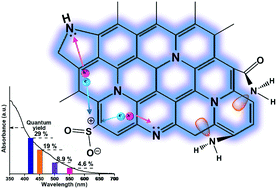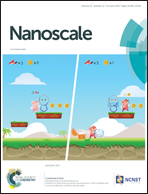Electronic structure manipulation of graphene dots for effective hydrogen evolution from photocatalytic water decomposition†
Abstract
This paper presents a heteroatom doping strategy to manipulate the structure of graphene-based photocatalysts for effective hydrogen production from aqueous solution. Oxygenation of graphene creates a bandgap to produce semiconducting graphene oxide, nitrogen doping extends the resonant π-conjugation to prolong the charge lifetime, and sulfur doping breaks the electron neutrality to facilitate charge transfer. Accordingly, ammonia-treated sulfur–nitrogen-co-doped graphene oxide dots (A-SNGODs) are synthesized by annealing graphene oxide sheets in sulfur-ammonia, oxidizing the sheets into dots, and then hydrothermally treating the dots in ammonia. The A-SNGODs exhibit a high nitrogen content in terms of quaternary and amide groups that are formed through sulfur-mediated reactions. The peripheral amide facilitates orbital conjugations to enhance the photocatalytic activity, whereas the quaternary nitrogen patches vacancy defects to improve stability. The simultaneous presence of electron-withdrawing S and electron-donating N atoms in the A-SNGODs facilitates charge separation and results in reactive electrons. When suspended in an aqueous triethanolamine solution, Pt-deposited A-SNGODs demonstrate a hydrogen-evolution quantum yield of 29% under monochromatic 420 nm irradiation. The A-SNGODs exhibit little activity decay under 6-day visible-light irradiation. This study demonstrates the excellence of the heteroatom-doping strategy in producing stable and active graphene-based materials for photoenergy conversion.



 Please wait while we load your content...
Please wait while we load your content...